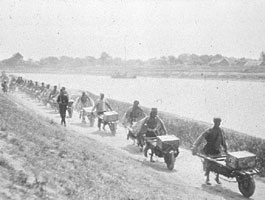What do we mean by Modern?
Appreciating Asian Dynamics
Nineteenth-and twentieth-century East Asia is often viewed in terms of the responses that people made in these countries to opportunities presented by the West and to pressures put upon these countries by Western political and economic forces. So we tend to think of what is modern in these countries in terms of the traits that they either learned from Western countries or had forced upon them through their connections to the West.
Comparing Modern China and Modern Europe [VIDEO]
TRANSCRIPT: When I talk about the relationships between politics and culture, even if I'm in a China-specific course, I will make the point that this relationship, in certain important ways, resembles what we see in Europe at a much later point in time.
That doesn't mean China is "modern" before Europe. In other words I'm suggesting that adjective is really not very useful. Rather it alerts us to a kind of activity, a set of traits that exists in China before it exists in Europe. And what I'm going to suggest when I get to my third topic is keeping track of those issues matters for when we move forward in time, in China. That is, thinking about the relationship between politics and culture. So, briefly put, the implications for teaching have to do with the ways in which we seek to introduce and explain different phenomena that we observe in China or some other part of East Asia in comparative contexts.
And here I'm stressing comparison, one of the things we'll get to, I'll get to in my next, theme is connections. But at this point, it's comparisons. It's to alert our students to the idea that some things happened in parts of the world before they happened in Europe. And that's a very important thing for them to grasp.
There is a serious problem with this perspective because there are traits that developed in these countries that we can think of as modern. The problem is that we tend to ignore, and indeed to not even see, the traits that existed in these countries that have a longer history. And if we notice them, we tend to think of them as anomalies or as something problematic, as an obstacle to people becoming more modern.
And what modern means then in this case increasingly resembles what took place in the West. It seems to me that this is problematic as an analytical perspective on what to expect or how things work. What is missing in particular is an appreciation of how dynamics that existed within each of these countries—within China, Japan, and Korea—influenced the ways in which change took place politically, socially, and economically in the nineteenth and twentieth centuries.
Some Things Happened in China First
Looking at China, we expect to see certain kinds of economic changes, which in certain senses resemble those that took place in Europe and America, but in other ways were distinctly Chinese. We think of social welfare as a national problem, as a modern national problem, which emerged in the nineteenth century, but it's not until the second half of the nineteenth century that we start to see European states caring about education.

Transporting rice to famine area in China, c. 1906.
Courtesy Jean Elliott Johnson
Caring about the welfare of people in cities beyond the capital itself is really a late-nineteenth- and twentieth-century development. However, in China, it's quite clear that governments have cared about the subsistence conditions—the food supply conditions of its people—for many, many centuries. And they have done so not merely on a local level, but spanning the entire country, which again, in the Chinese case, because it was an empire, is the equivalent of many European countries put together.
What do we do, then, in terms of understanding the significance of those developments? We tend to discount their importance because they don't fit our expectations of what governments do until a later point in European history; therefore, we can't take seriously that these developments in China take place before comparable developments take place in Europe. And that, again, makes it difficult for us to see the importance of these in a Chinese setting because we don't have any comparable European examples until a later point in time.
Partial Parallels: Other Places, Other Times [VIDEO]
TRANSCRIPT: Does this mean that China before the nineteenth century was "modern"? No, that's really not the argument that I seek to make. Rather, it's to alert us that what we take as "modern," because it occurs in nineteenth-century Europe, doesn't mean that certain of those traits don't occur in other parts of the world before the nineteenth century.
And that should undermine the ease with which we associate certain kinds of practices as "modern." We should not think of modernity as simply a certain set of practices; rather we should recognize that what we mean by "modernity" often is the existence of a range of activities and beliefs that occur in the Europe at the same time. And so what is "modern" really ends up being a very complicated and spatially specific notion in the way it's used by many historians to refer to traits that emerge in Europe together.
And once we recognize that this is true, it allows us, it liberates us to look for and recognize the existence of partial parallels, some kinds of similarities, in other places at earlier times. And this then allows us to be careful not to assert that what takes place in Europe in the nineteenth century necessarily is the first or only time that certain types of activities took place in world history.